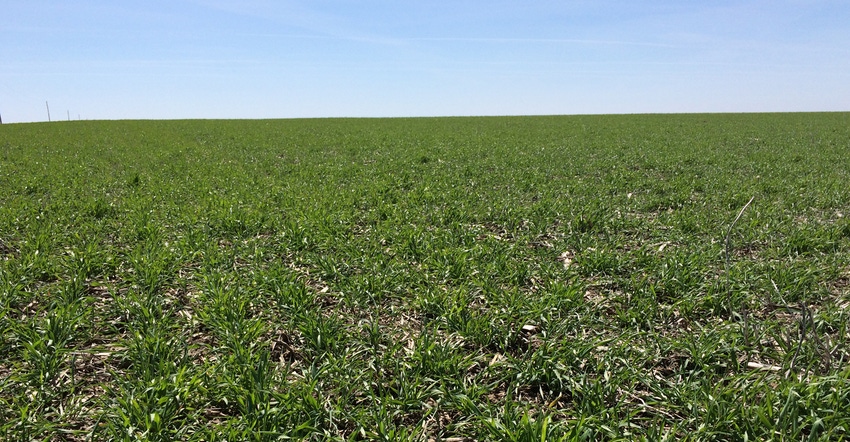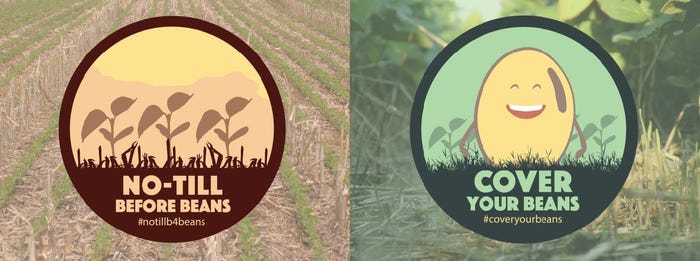October 8, 2018

At the Farm Progress Show in Boone, Iowa, in late August, the Conservation Learning Group, based at Iowa State University, kicked off a yearlong social media campaign designed to spread the word about cover crop and no-till benefits for soybean growers.
We’ve created #coveryourbeans and #notillb4beans hashtags to make it easy for farmers to tell the community how these techniques are working on their farms.
Our goal is to kick-start conversations about cover crop and no-till benefits, concerns and results that farmers are experiencing throughout Iowa. When employed together, no-till and cover crops are proving to be excellent strategies for land management and control of runoff. And we want to encourage everyone to share their stories.
We got some initial feedback from farmers during the show — some positive and some challenging. This is not new, and I’m happy to report that there were more than a few who were enthusiastic about the results. We’ve also started hearing some creative approaches to improving return on investment for cover crops.
Ways to improve ROI
One farmer commented that grazing cover crops in the fall and before termination in the spring tipped the ROI scale to the positive. While not all row-crop farmers raise enough livestock to see a substantial savings on winter feed, it worked for this farmer. Cereal rye is a hearty crop, and particularly in warm winters such as the one experienced in 2017-18, the potential for grazing well into the winter months is always there.
Another noted that after harvesting corn for silage, there was an extended fall grazing period for the cereal rye. In addition, combining no-till with the cover crop significantly increased biomass in the soil — to the benefit of the following soybean crop. It’s difficult to put a dollar amount against the increased biomass, but increased nutrient cycling and improved soil health are always good outcomes.

SPREAD THE NEWS: The hashtags #coveryourbeans and #notillb4beans help spread the word about the benefits of no-till and cover crops.

We also heard concerns about the cost of planting and terminating the cover crop. These are hard costs, and every farmer will have to weigh the costs against the benefits — an equation that is admittedly more difficult to monetarily balance for those not also raising livestock. In addition, the environmental benefits of nutrient retention and decreases in erosion should factor into a holistic view of a cost-benefit analysis.
Yield penalty for row crops?
Another comment that we heard at the show, and hear regularly at field days and seminars, is, “What about the yield penalty for corn or soybeans planted following cover crops?” Time and study will eventually dispel the notion of yield penalties, but we welcome the question and are making strong progress in overcoming this notion.
In fact, Iowa Learning Farms and Practical Farmers of Iowa are gathering harvest data for the 10th year of a field-scale research study examining cover crop impacts and benefits. Field-scale studies of this length are uncommon, but the participating partner-farmers have stuck to their commitments and have also been mostly pleased with the results.
In a nutshell, after nine years, farmers reported that in 59 of 63 site-years, properly managed cover crops had little to no effect on corn and soybean yields, and increased soybean yield in eight site-years and corn yield in two site-years. We anticipate the Year10 results will bolster the positive outcomes, but that’s a subject for another entire article.
Delivering information on cover crops
So, how can we get the word out to farmers? We all know that most farmers love to share their successes and challenges among their peers. It happens at field days, fairs and coffee shops. We want to ramp up that conversation and make use of social media to spread the stories to a broader audience. This brings us back to #coveryourbeans and #notillb4beans.
We’re starting small but hope to go viral very soon. Our first farmer tweet using the hashtags hit the net in late September, with @farmerdoug93 encouraging farmers to get moving with cover crops now to see the benefits next spring.
We’ve seen real benefits in our field research, and we’re hearing more success stories and positive comments from farmers across Iowa regarding no-till and cover crops. Our goal with this program is to raise awareness now when farmers are harvesting and planning for next year’s crops.
So, if you’ve got a story to tell about no-till and cover crops, please share it with the community using #coveryourbeans and #notillb4beans.
Licht is an Iowa State University assistant professor and Extension Cropping Systems Specialist, and Conservation Learning Group Leadership Team Member.
About the Author(s)
You May Also Like






